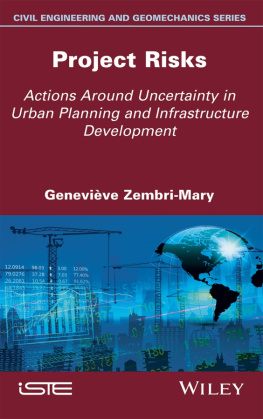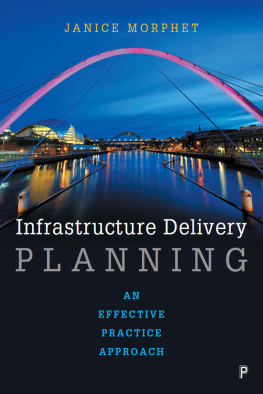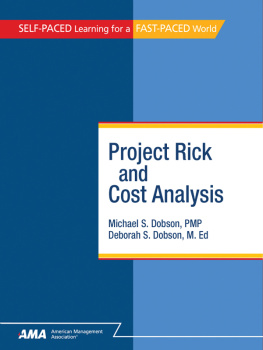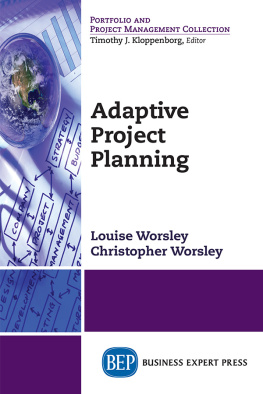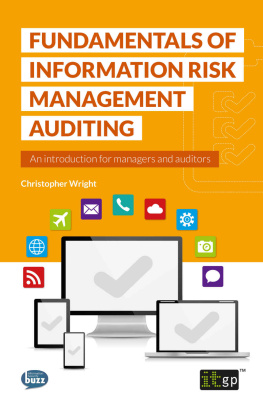
Series Editor
Gilles Pijaudier-Cabot
Project Risks
Actions Around Uncertainty in Urban Planning and Infrastructure Development
Genevive Zembri-Mary

First published 2019 in Great Britain and the United States by ISTE Ltd and John Wiley & Sons, Inc.
Apart from any fair dealing for the purposes of research or private study, or criticism or review, as permitted under the Copyright, Designs and Patents Act 1988, this publication may only be reproduced, stored or transmitted, in any form or by any means, with the prior permission in writing of the publishers, or in the case of reprographic reproduction in accordance with the terms and licenses issued by the CLA. Enquiries concerning reproduction outside these terms should be sent to the publishers at the undermentioned address:
ISTE Ltd
27-37 St Georges Road
London SW19 4EU
UK
www.iste.co.uk
John Wiley & Sons, Inc.
111 River Street
Hoboken, NJ 07030
USA
www.wiley.com
ISTE Ltd 2019
The rights of Genevive Zembri-Mary to be identified as the author of this work have been asserted by her in accordance with the Copyright, Designs and Patents Act 1988.
Library of Congress Control Number: 2019945373
British Library Cataloguing-in-Publication Data
A CIP record for this book is available from the British Library
ISBN 978-1-78630-184-0
Introduction
The planning, design, and implementation of infrastructure, development, and urban planning projects are characterized by traditional project management objectives (time, cost, and quality) as well as multi-sectoral objectives that juxtapose the former. They may concern environmental protection, spatial planning, local development, urban regeneration, accessibility, and so on.
The current economic crisis, which no longer ensures easy use of public funding; the increased use of private project financing, led by banks concerned about their return on investment; a growing sensitivity to respect the human and natural environments of projects; and regulatory changes, are placing the issue of risks and uncertainties at the heart of the decision-making, planning and project management process, and we are creating opportunities.
DEFINITION OF RISK AND UNCERTAINTY. We use the following definition to clarify the notions of risk and uncertainty: Risk is the possibility that events, their resulting impacts and their dynamic interactions will turn out differently than anticipated. Risk is typically viewed as something that can be described in statistical terms, while uncertainty is viewed as something that applies to situations in which potential outcomes and causal forces are not fully understood (Miller and Lessard 2008, p. 148). It is important to distinguish between uncertainty management, which refers to the precautionary principle, and risk management, which refers to prevention. The precautionary principle implies that actors anticipate the potential risks of a technology or event when they are not known.
These uncertainties and risks are multiple. They can be political (in the event of disagreement, sometimes unexpected, between the communities and the project owner who finance the project), social (in the event where associations or the public dispute the project), institutional (in the event of a change in regulations which impacts the project), archeological (in the event of the discovery of a site on the project site), environmental (in the event of the project impacting the natural or human environment), financial (in the event of delays that generate additional costs), commercial, or technical. Uncertainty and risk can also produce opportunities that are organized according to the same typology.
Uncertainty, risks, opportunities, and management of mega infrastructure projects
Research on project uncertainty and risk has emerged in parallel with the development of the use of publicprivate partnerships. This involves research on megaprojects (notably transport, electricity production, etc.) but not on more modest urban planning projects (subdivisions, malls, sports and cultural facilities, etc.). The allocation of risks between public and private partners and their monetarization have been the subject of work since the 1990s (Arndt 1998; Faruqi and Smith 1997; Forshaw 1999; Ward et al. 1991). The initial approach evolved toward the development of typologies of risks that could impact the project, and of optimized methods for identifying, analyzing, reducing, avoiding, or transferring risks (Grimsey and Lewis 2002), and then toward methods for evaluating complex interplay of actors specific to planning (Macharis and Nijkamp 2013).
Beyond that, research has also focused on taking into account unforeseen events such as conflicts in the conduct of long-term publicprivate partnership contracts (Gould 1998). A field of research has also been opened up on cooperation between actors within the framework of partnership contracts (Campbell and Harris 1993; Siemiatycki 2013).
Bent Flyvbjerg et al. (2003) have shown the risks inherent in major projects (Channel Tunnel, airports, dams, etc.). They link them to the difficulty of predicting construction costs and to more difficult planning due to changing investor and resident demand. According to them, the main risk is that the main purpose of these major projects may be diverted because of the poor compatibility between financial rationality driven by private investors and social and environmental objectives. This work was carried out using an economic approach.
More recently, research has focused on the decision-making process that accompanies the planning and design of major projects. In particular, work focused on the adaptation of planning modalities by actors and the impact of democracy on the progress of this process (Priemus and Van Wee 2013).
The consideration of risks and uncertainties in the planning, evaluation, and design of transport projects was the subject of international research led by University College London (Bartlett School of Planning) between 2006 and 2013. This research made it possible to identify a set of good practices for risk analysis and treatment based on a review of the decision-making process of 30 transport infrastructure projects in 10 countries in Europe, Asia, and America. The central research question aimed to define what constitutes a successful project in relation to traditional criteria of time, cost, and quality and in relation to the context of the project (objectives emerging as the project progresses, social, political, and environmental change, different and evolving visions of the different actors, etc.).
The analysis of the decision-making and planning process of these projects has made it possible to identify good practices to deal with the risks and uncertainties resulting from the evolving nature of the projects and their contexts. We retain those relating to the different categories of actors (OMEGA 2012):
- overall, the lessons learned from the case studies suggest the need for concerted action among partners, including a change in project thinking and development processes;
- policies can lead to changes in schemes and programs in relation to the context and to the consideration of projects as open systems that are likely to be exposed to risks and uncertainties;
- public partners can play an important role in assessing the key factors that can play a role in the success or failure of the project;
Next page
